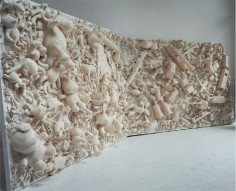Lin Tianmiao
林天苗
Boys and Girls
source: themodernsybarite
The idea of authentic art has somewhat been lost by the mainstream – today many people buy with their ears and not with their eyes (and head) and artists produce for these buyers so it becomes a sad vicious circle. Luckily there is an artist today that oozes authenticity: Lin Tianmiao.
Born in 1961 in China, Lin grew up helping her mother winding balls of cotton thread for her sewing projects. The process is far from mindless; you see the basis of doing it correctly is to have an infinite amount of perseverance, concentration and patience. Before you wind, you need to think how it will unwind otherwise you end up with unusable thread. And it’s this experience that Lin came back to when she reinvented herself as an artist in her early 30s.
After an 8-year stint in Brooklyn, New York with her husband (the equally acclaimed artist Wang Gongxin), Lin went back to China in 1995 only to find venerated objects of the past being disregarded by the “new” and more open society. It was by “embalming” these objects in thread (chopsticks, bicycles, tools and machines) that Lin began her artistic career. And she is on the ascent!
Much like another contemporary Chinese artist I wrote about previously, Wang Guangle, Lin’s work is rooted in her past and is a reflection of the present. It’s remarkably authentic.
.
.
.
.
.
.
.
source: artspeakchina
林天苗于1961年出生于中国山西省太原。
林天苗童年时期对图案有着特别的天分。若干年之后,她将这种天分转变为一种职业,在成为艺术家之前,她是纽约一名成功的纺织品设计师。
教育和发展
林天苗于1984年毕业于北京首都师范大学美术系,之后于20世纪80年代后期在纽约市艺术学生联盟深造。
从1998年开始,林天苗已经在帆布上创造了一系列关于她自己的苍白、像鬼一样的摄影形象,悬挂着展览区半透明的屏幕上。
《辫》
在她1998年名为《辫》的展览中,林天苗安装了一条长达12英尺高的帆布,帆布上她的灰色调脸部形象被表明随意分布的缝线弱化了,每根线都延伸到地面,并卷绕在一起。这些线代表着构成一种文化的细微习惯与习俗,以及随意破坏的困难。 (下:《辫》,印刷在丝绸和棉帆布上的照片,1998年)
在《聚焦》中,林天苗试图研究有关肖像、身份和性别的问题。她在一个新的方向发展了她的手法,尝试重新定义她运用各种材料的能力和进一步挑战自我。她说:“对我而言,每件作品都代表着将要战胜的挑战。”
在这一系列中,观赏者需要决定如何理解一幅大尺寸的脸部照片。林天苗没有尝试采用不必要的装饰来填充其作品的表面。相反,她让作品保持平静朴实,希望观赏者也能有相同的感受。她说:“目的是为观众提供一些纯粹简单的东西,一些实际上包含着很多意义和表情的东西。”
作为对若干个有关京剧的问题的回应,林天苗创作了《手势》系列。尽管受到京剧的影响,但是她想知道为什么男人会饰演女性的角色。她在一次访谈中谈到:“为什么要进行这种性别的改变?为什么京剧演员的手势如此重要,作为一种视觉语言用如此平静微妙的动作来表达这么多的活动和运动?”这一系列的问题促使林天苗创作了《手势》,希望能够解答这些问题和解开他们所代表的社会含义。不过,在该系列的最后,她没找到答案。她说:“尽管我们生活在中国,但是我们事实上并不了解中国的传统,例如京剧中的这些手势。”她发现她对京剧和中国其他美术传统的了解非常有限,但是她认为,这个微妙的手势可以永久地固定在观赏者的记忆里。
.
.
.
.
.
.
.
source: we-find-wildness
LIAN TIANMIAO lives and works out of Beijing creating predominantly installation pieces. She has made a career transforming silk, threads and textiles into elaborate works of art and also for her experimentation with photography and video. Her art has a textural and tactile nature that plays on the senses.
Her haunting monochrome portraits (presented above) feature androgynous faces, veiled with strands of thread sewn into the canvas. Printed on handmade paper, these works blend lithography, embossing, and the incorporation of embedded elements, lending them unique texture and dimensionality: “Arising from a culture that has traditionally been marked by the subordination of the individual to the collective, these works all reflect the emergence of hybrid new conceptions of selfhood and personal identity in contemporary China.”
The resulting works are haunting, delicate, and arresting.
.
.
.
.
.
.
.
source: galerielelong
Born in Taiyuan, Shanxi Province in 1961, Lin Tianmiao is one of the first female artists from China to achieve international recognition. During the 1980s, Lin studied in the Fine Art Department of the Capital Normal University in Beijing. Following her studies, she moved to New York with her husband Wang Gongxin, a celebrated video artist. They returned to China in 1995, where they now reside. Early in her career, Lin worked as a successful textile designer, later translating her experience along with the crafts of weaving, sewing, and embroidery into her practice as a visual artist.
Best known for her installations—such as The Proliferation of Thread Winding (1995) consisting of a bed of needles linked to individually hand-wrapped balls of white cotton thread, with a monitor depicting the artist’s painstaking handicraft laid beneath a sheer pillowcase—Lin also works in sculpture, photography, video, and a variety of other media. Like The Proliferation of Thread Winding, much of her work addresses women’s issues. Lin links thread and the activity of binding and weaving to the female experience and her Chinese background, but the final result evokes a shared human experience for the viewer, regardless of gender, race, or nationality. Conceptual and obsessed with the intricately hand-made, Lin’s work operates within numerous dichotomies such as the private vs. public, personal vs. cultural, male vs. female, natural vs. unnatural, remembered past vs. lived present. Through the use of common materials and the transformation of quotidian objects, Lin evokes personal interpretations for each viewer while maintaining a universally recognized experience.


